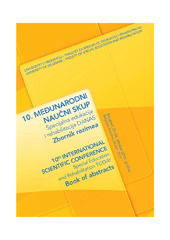Приказ основних података о документу
Slušni uzrast kao faktor razvoja lingvističkih veština kod dece korisnika kohlearnog implanta i slušnih aparata
Hearing age as a factor of linguistic skills development in children using cochlear implant or hearing aids
| dc.contributor | Žunić Pavlović Vesna | |
| dc.contributor | Grbović Aleksandra | |
| dc.contributor | Radovanović Vesna | |
| dc.creator | Ostojić-Zeljković, Sanja | |
| dc.creator | Nikolić, Mina | |
| dc.date.accessioned | 2021-06-17T14:00:42Z | |
| dc.date.available | 2021-06-17T14:00:42Z | |
| dc.date.issued | 2019 | |
| dc.identifier.isbn | 978-86-6203-130-3 | |
| dc.identifier.uri | http://rfasper.fasper.bg.ac.rs/handle/123456789/3153 | |
| dc.description.abstract | Korisnici amplifikacije ili kohlearnog implanta karakterišu se sa dve uzrasne kategorije: hronološki i slušni uzrast. Što je razlika između hronološkog i slušnog uzrasta manja, očekuje se da su i efekti surdološke intervencije značajniji. Savremeni modeli amplifikacije i primena kohlearnog implanta, u poslednjih dvadeset godina doveli su do značajnih promena u lingvističkim sposobnostima gluve i nagluve dece. Predmet ovog istraživanja je analiza stvarnih lingvističkih sposobnosti gluve i nagluve dece sa posebnim osvrtom na uticaj slušnog uzrasta na razvoj ovih sposobnosti. Cilj istraživanja je da se utvrdi uticaj slušnog uzrasta na razvoj stvarnih lingvističkih sposobnosti kod gluve i nagluve dece sa različitim modelima amplifikacije. Uzorak u ovom istraživaju obuhvata 43 ispitanika, uzrasta od 5 do 8 godina, sa različitim stepenom oštećenja sluha, amplifikovanih slušnim aparatima (19) i korisnika kohlearnog implanta (24). U okviru istraživanja je primenjen Profil stvarnih lingvističkih veština (PALS, 2004, Ear Foundation) koji procenjuje: svakodnevne veštine komunikacije, receptivne veštine, ekspresivne veštine, glasovne veštine i govorne veštine na različitim nivoima. Za obradu podataka korišćene su metode deskriptivne statistike (frekvencije, procenti) i bivarijantni hi- kvadrat (χ2) test za procenu statističke značajnosti među varijablama. U odnosu na slušni uzrast uzorak je podeljen u 3 kategrije: do 2 godine, od 2 do 4 godine i od 4 do 6 godina. U ukupnom skoru primenjenog testa, slušni uzrast pokazao je statistički značajan uticaj (p = 0,014) na ispitivane sposobnosti. I u primenjenim podtestovima svakodnevnih veština komunikacije: opseg namera u komunikaciji (p = 0,011), efikasnost komunikacije (p = 0,013); u podtestu receptivne veštine komunikacije (p = 0,012); slušanje i čitanje sa usana (p = 0,014) takođe se pokazao statistički značajan uticaj slušnog uzrasta. Najbolja postignuća ustanovljena su kod ispitanika slušnog uzrasta između 2 i 4 godine. | |
| dc.description.abstract | Cochlear implant or hearing aid users are defined by two categories of age: chronological and hearing age. The effect of surdological intervention tend to be more prominent when the difference between those two age categories is lesser. Apart from that, the actual linguistic skills of deaf and hard of hearing children have improved tremendously over the past two decades due to wider implementation of cochlear implants and digital hearing instruments. The objective of this study was to analyze the actual linguistic skills of deaf and hard of hearing children with special focus on the impact of hearing age. The goal of the study was to determine the impact of different amplification modes (cochlear implant vs. hearing aids) on the development of actual linguistic skills in deaf and hard of hearing children. The sample consisted of 43 children, 5 to 8 years of age, with different degree of hearing loss, using hearing aids (19) or cochlear implant (24). The instrument in this study was the Profile of Actual Linguistic Skills (PALS, 2004, Ear Foundation) which was used to assess everyday communication skills, both receptive and expressive, voice quality and speech skills (pre-verbal, transitional and functional). The data was analyzed using descriptive statistics of category variables (frequency, percentage and bivariant χ2 test for assessment of statistical significance of difference between variables). The children were divided in three categories according to their hearing age: less than 2 y, 2-4 y and 4-6 y. Hearing age showed a statistically significant effect on overall test results regarding linguistic skills (p = 0.014) as well as in the subtests of everyday communication skills: span of communication intention (p = 0.011), communication effectiveness (p = 0.013), receptive communication skills (p = 0.012) and listening and lip reading (p = 0.014). The best performing group in this study of actual linguistic skills was the one with hearing age 2 to 4 years. | |
| dc.language | sr | |
| dc.publisher | Univerzitet u Beogradu – Fakultet za specijalnu edukaciju i rehabilitaciju/ University of Belgrade – Faculty of Special Education and Rehabilitation | |
| dc.relation | info:eu-repo/grantAgreement/MESTD/Basic Research (BR or ON)/179055/RS// | |
| dc.rights | openAccess | |
| dc.rights.uri | https://creativecommons.org/licenses/by-sa/4.0/ | |
| dc.source | Zbornik rezimea - 10. Međunarodni naučni skup „Specijalna edukacija i rehabilitacija danas“, Beograd, Srbija, 25–26. 10.2019. | |
| dc.subject | lingvističke veštine | |
| dc.subject | slušni uzrast | |
| dc.subject | kohlearni implant | |
| dc.subject | slušni aparat | |
| dc.subject | linguistic skills | |
| dc.subject | hearing age | |
| dc.subject | cochlear implant | |
| dc.subject | hearing aid | |
| dc.title | Slušni uzrast kao faktor razvoja lingvističkih veština kod dece korisnika kohlearnog implanta i slušnih aparata | sr |
| dc.title | Hearing age as a factor of linguistic skills development in children using cochlear implant or hearing aids | |
| dc.type | conferenceObject | |
| dc.rights.license | BY-SA | |
| dc.citation.epage | 145 | |
| dc.citation.other | http://www.fasper.bg.ac.rs/nauka/medjunarodni-skup-doc/2019/20191028_2-Book-of-abstracts-2019-CD.pdf | |
| dc.citation.spage | 144 | |
| dc.identifier.fulltext | http://rfasper.fasper.bg.ac.rs/bitstream/id/7924/hfsdfbsh.pdf | |
| dc.identifier.rcub | https://hdl.handle.net/21.15107/rcub_rfasper_3153 | |
| dc.type.version | publishedVersion |


